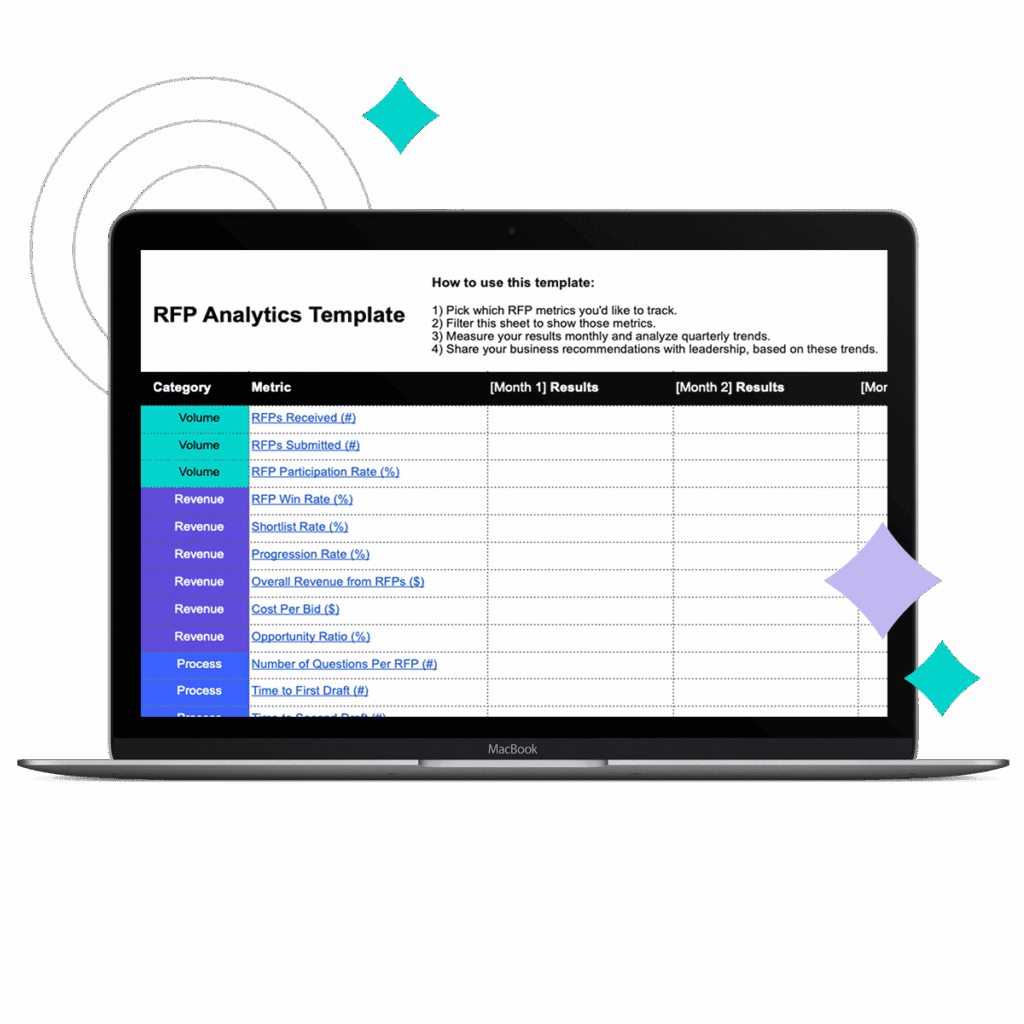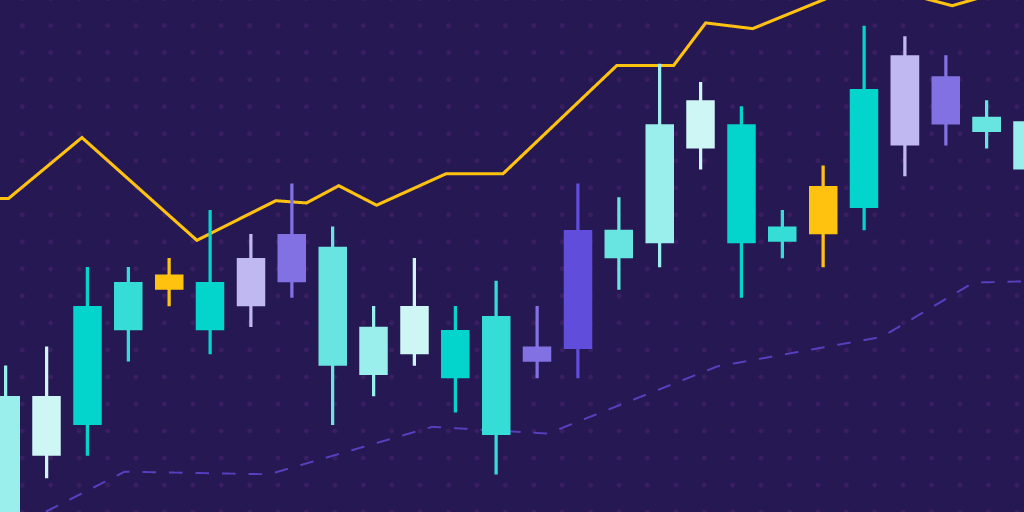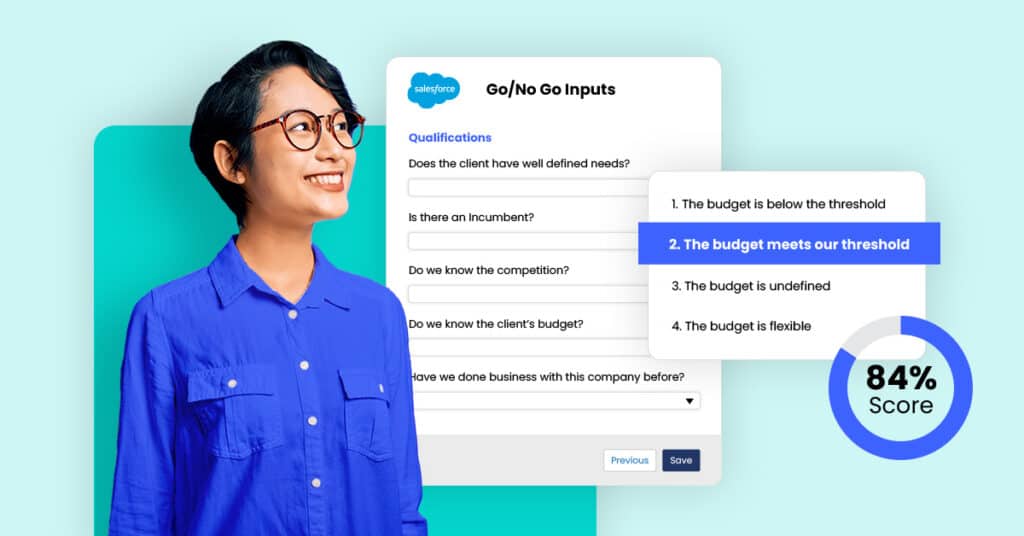RFP Analytics Template: 21 Proposal Metrics to Track

How Do You Track Proposal Success? Rally Your Team Around RFP Analytics.
Is your proposal team flourishing without the numbers to back it up? Use this RFP Analytics Template to track performance, share bid insights, and celebrate wins.
Learn how to track RFP metrics and aim for benchmarks, like:
44%
Average Win Rate
Measure how many deals closed, thanks to your RFP-savvy team.
26 hours
Overall Writing Time
Prove that a quality proposal puts you at the top of the shortlist.
65%
RFP Participation Rate
Show why it’s important to separate the duds from the dollars.
“CEOs and sales leaders employ us to help win business – but you can’t measure a proposal team on win rates alone. There’s so much more that influences the outcome. But imagine your win rate is zero: would that feel right? No! Win rate has to be a critical part of the mix.”

Download Your RFP Process Checklist
FAQs About RFP Checklists
RFP analytics, also known as Request for Proposal analytics, refers to the process of collecting, analyzing, and deriving insights from data related to the creation, distribution, and evaluation of Request for Proposals (RFPs).
It involves using data and metrics to improve the efficiency, effectiveness, and outcomes of an organization’s RFP processes. RFP analytics can provide valuable insights into various aspects of the RFP lifecycle, including vendor selection, procurement, and contract management. Here are some key aspects of RFP analytics:
Proposal Evaluation and Scoring
RFP analytics can help evaluate and score vendor proposals more objectively by quantifying the assessment of proposal criteria. It may involve the use of scoring models to rank and compare proposals.
Vendor Performance
By tracking and analyzing vendor performance data, organizations can identify trends, strengths, and weaknesses of various vendors, helping them make more informed decisions when selecting vendors for future projects.
Response Times
Analyzing the time it takes for vendors to respond to RFPs can help organizations assess vendor responsiveness and commitment.
Cost Analysis
RFP analytics can assist in comparing and analyzing the cost elements of vendor proposals, allowing organizations to make more cost-effective decisions.
Proposal Content
Analyzing the content of vendor proposals can help identify patterns, common themes, or areas that need improvement in the RFP process.
Compliance and Risk Assessment
Assessing compliance with RFP requirements and analyzing potential risks associated with vendor proposals or contracts.
Benchmarking
Comparing RFP outcomes with industry benchmarks or historical data to identify areas for improvement.
Workflow Efficiency
Analyzing the efficiency of the RFP process, including time spent at each stage, bottlenecks, and opportunities for automation.
Reporting and Visualization
Generating reports and visualizations to present RFP data in a clear and understandable format for decision-makers.
Predictive Analytics
Using historical RFP data to make predictions or forecasts related to future RFP outcomes, such as vendor selection or project success.
RFP analytics can be instrumental in enhancing the decision-making process, increasing transparency, and identifying areas for process improvement within an organization’s procurement and vendor selection procedures. It allows organizations to leverage data-driven insights to optimize their RFP processes and, ultimately, achieve better results in vendor selection and project execution.
Analyzing a Request for Proposal (RFP) is a critical step in the procurement and vendor selection process. Proper analysis ensures that your organization understands the project’s requirements, evaluates vendor proposals effectively, and makes informed decisions. Here’s a step-by-step guide on how to analyze an RFP submitted as part of a procurement process:
- Review the RFP document
- Identify stakeholders
- Create an RFP analysis team
- Understand evaluation criteria
- Divide and conquer the evaluation into sections and reviewers:
- Verify vendor eligibility
- Ensure proposal compliance
- Assess the technical aspects of each proposal
- Check the financials, verifying that the pricing aligns with the project’s budget
- Contact references provided by the vendors to assess their past performance on similar projects
- Evaluate potential risks associated with each vendor, such as financial stability, scalability, and project management capabilities
- Assess risk mitigation strategies proposed by the vendors
- Scoring and ranking using predetermined criteria
- Make your final decision:
- RFP response process: Notify potential vendors (winning and losing)
- Contract negotiation
Proper RFP analysis is essential for selecting the best vendor and ensuring that the chosen proposal aligns with your project’s goals and objectives. Effective analysis helps your organization make informed decisions and set the stage for a successful project.
Metrics for Request for Proposal (RFP) processes help organizations evaluate the efficiency and effectiveness of their procurement and vendor selection efforts. These metrics provide valuable insights into various aspects of the RFP process, allowing organizations to identify areas for improvement and make data-driven decisions.
Here are some common metrics used to assess RFP processes:
- Response time
- Proposal completion rate
- Compliance rate
- Evaluation time
- Scoring consistency
- Vendor qualification rates
- Cost savings
- Vendor performance
- Vendor (and potential vendors) satisfaction
- RFP completion time
- Response quality
- Conversion rate
- Project success rate
- RFP feedback analysis
- Budget adherence
- Risk assessment effectiveness
- Vendor diversity
These metrics can be tailored to the specific needs and goals of your organization and the nature of the RFP. Regularly tracking and analyzing these metrics can help optimize your RFP processes and enhance the overall effectiveness of your procurement and vendor selection efforts. Data analytics services, business analytics software, or RFP software can help with the tracking of these success metrics.


